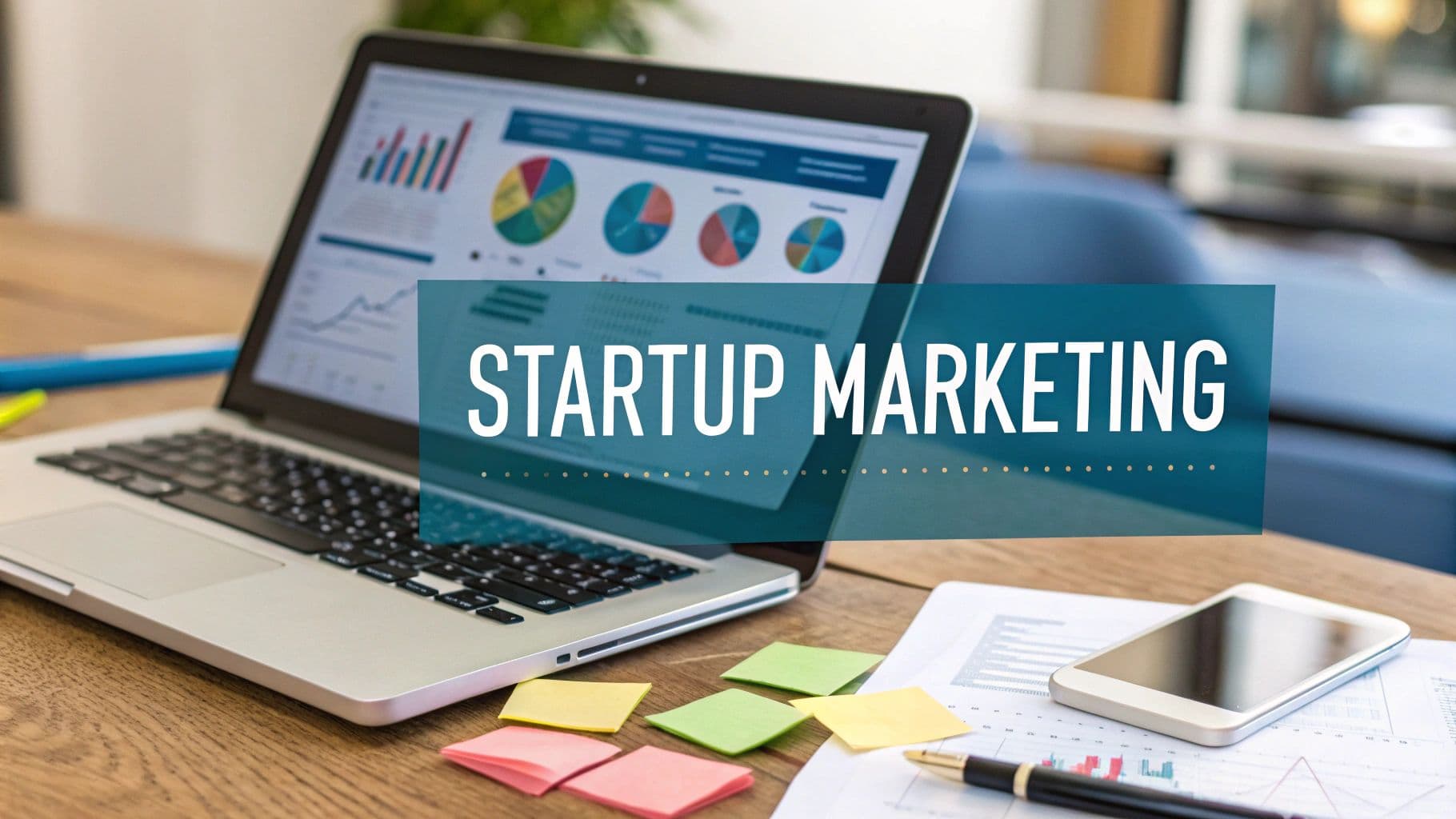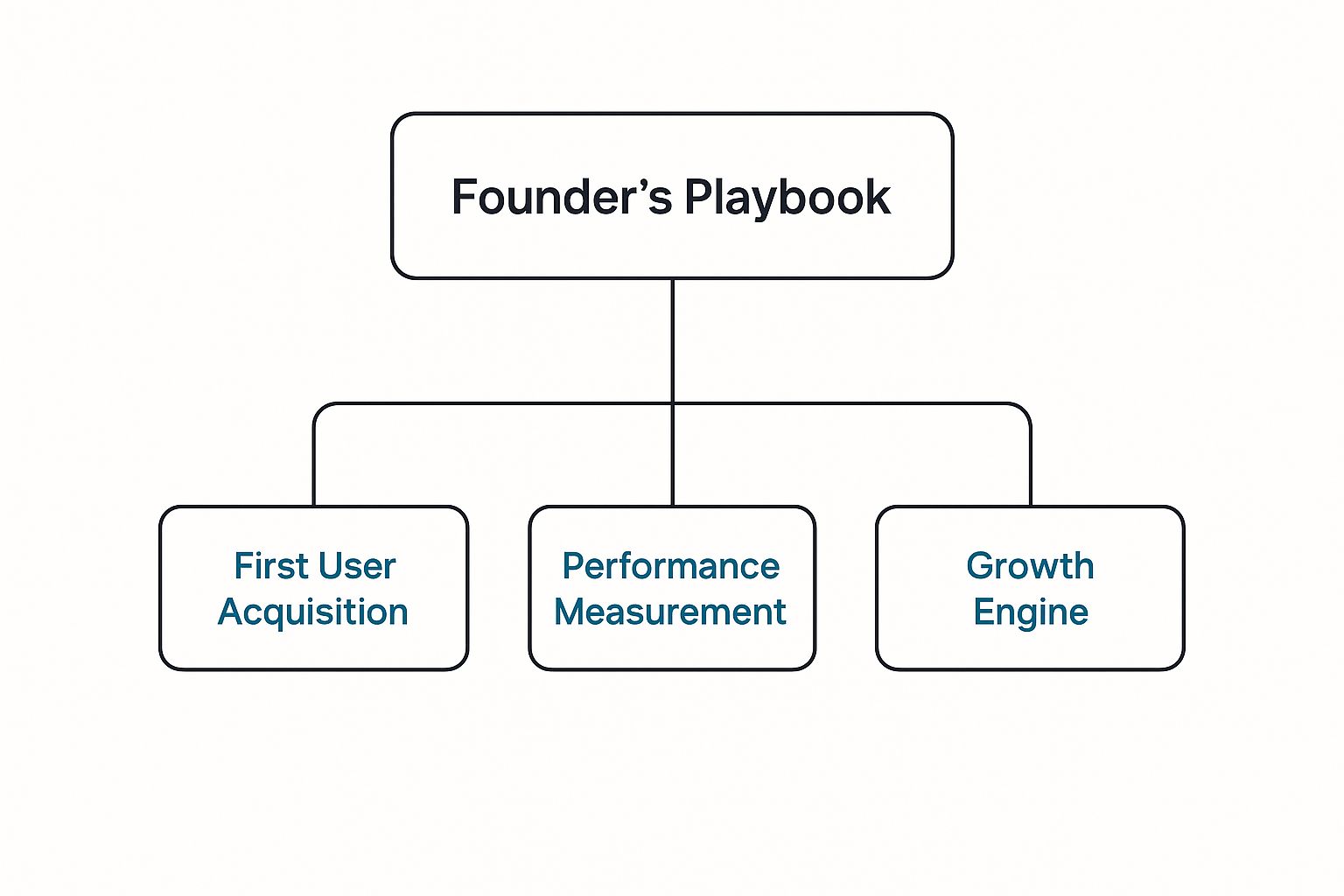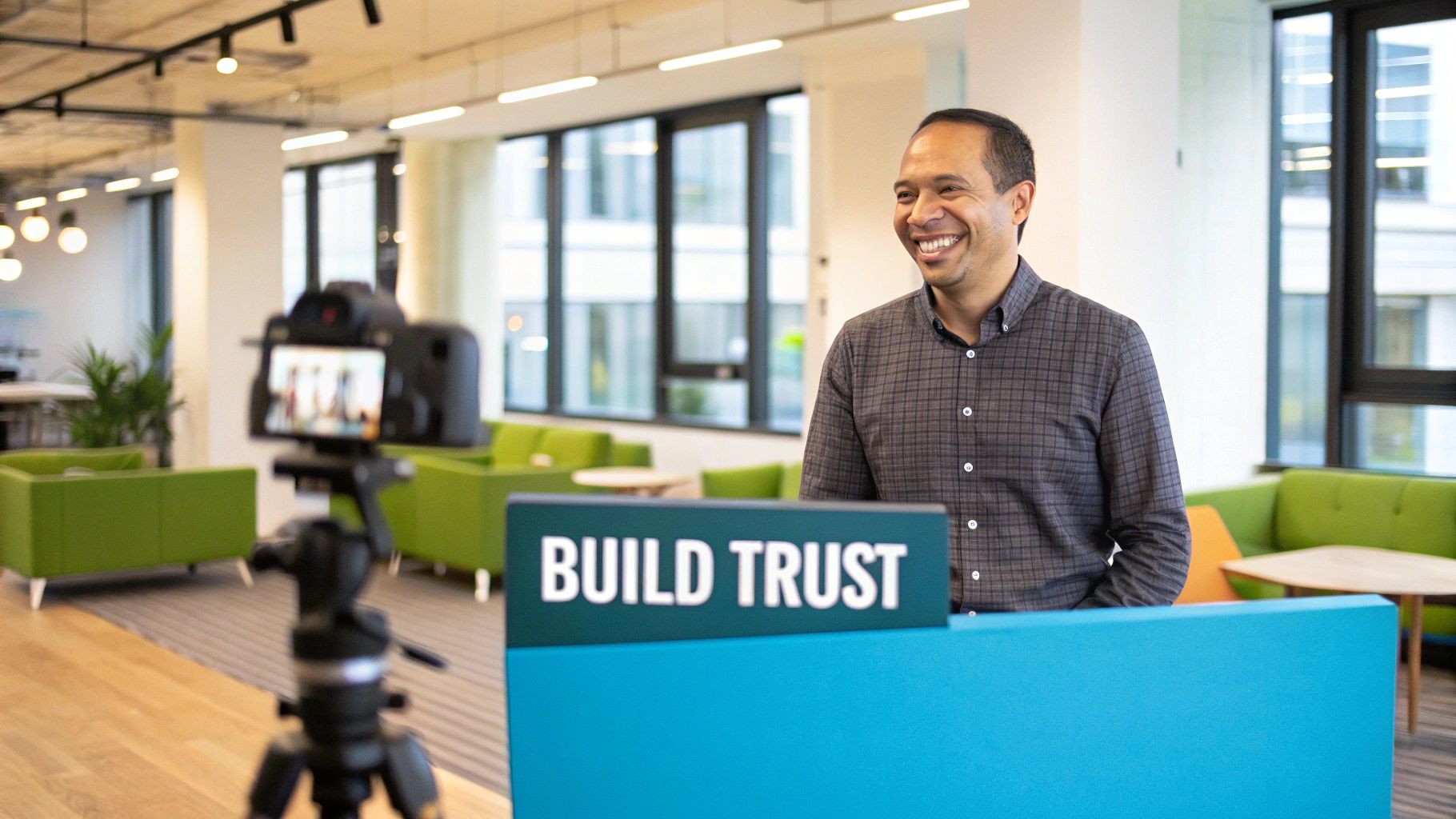
Let's ditch the marketing textbooks. As a founder, your marketing strategy isn't about impressions or awards. It’s a scrappy, founder-led playbook to do one thing: land your first customers when time and money are tight.
This is a direct engagement strategy. It's about getting rapid feedback and using marketing to find product-market fit. This is what we do inside BillyBuzz.
The Founder's Playbook for Startup Marketing
You're not playing the same game as the big guys. Your marketing can't be a complex, multi-channel beast. It needs to be a lean, focused system built for survival. At BillyBuzz, we ignored the conventional wisdom that pressures you to be everywhere at once.
This playbook cuts through the noise. It focuses on three core pillars that actually drive traction on a shoestring budget. The goal is to stop hoping something works and start building a repeatable engine.
The Three Pillars of Early-Stage Marketing
Your journey begins with a simple framework. Forget grand campaigns; this is about surgical action.
- First User Acquisition: The nitty-gritty, unscalable work of finding where your ideal customers hang out online and talking to them like a human.
- Performance Measurement: Tracking what truly moves the needle—metrics tied directly to revenue, not vanity stats like likes or shares.
- Growth Engine Creation: Turning what you've learned into a repeatable process that can scale.
This hierarchy gives you a clear path.

This structure ensures every marketing dollar and minute is purposeful, measurable, and contributes to a sustainable growth model.
Why This Lean Approach Is Crucial
Let's be real: 90% of startups fail. A staggering 42% of those failures happen because they built something nobody wanted. This hammers home how critical it is to have a marketing strategy that prioritizes real-world feedback.
A founder-led marketing strategy forces you to get uncomfortably close to your customers. The insights from those initial, hands-on interactions are more valuable than any market research report.
By starting with direct engagement, you aren't just selling; you're co-creating your product with your earliest fans. This helps you build something people genuinely need—the ultimate marketing advantage.
For a deeper dive into specific tactics, exploring these 10 proven startup marketing strategies can provide a solid foundation.
The BillyBuzz Startup Marketing Focus Framework
This is the difference between the old way of thinking and the founder-led approach we use. It’s about shifting your mindset from broadcasting to building relationships.
| Pillar | Traditional Approach | BillyBuzz Founder-Led Approach |
|---|---|---|
| Audience | Broad demographic targeting | Hyper-specific Ideal Customer Profile (ICP) |
| Channels | Be on every platform | Master 1-2 channels where your ICP lives |
| Messaging | Polished, corporate branding | Authentic, direct, and problem-focused |
| Metrics | Vanity metrics (impressions, followers) | Action metrics (sign-ups, demos, sales) |
| Goal | Brand awareness | Acquiring first 100 paying customers |
Use this framework as a filter to decide where to invest your most precious resources: your time and your cash.
How to Find Your First 100 Users for Free
When you're just starting, forget about SEO and paid ads. Your first 100 users aren't going to stumble upon you—you have to go out and find them. This is the unscalable, hands-on grunt work that builds a loyal user base and gives you priceless feedback.
Think spear-fishing, not net-fishing. Pinpoint the exact online communities where your ideal customers are already talking about the problem you solve. For the first six months, this was our entire marketing plan at BillyBuzz.

Setting Up Your Listening Posts
Before you jump into a conversation, listen. Find high-intent discussions where your product is a natural, helpful solution. This isn't about spamming links; it's about surgical interception. We built our initial user base by living in the right online communities.
Here’s the exact setup we used at BillyBuzz to keep an ear to the ground on Reddit, one of the best places for authentic user discovery.
Our Monitored Subreddits:
- /r/startups: Goldmine for feedback from fellow founders.
- /r/SaaS: Essential for B2B software. Full of conversations about tools, growth, and operational headaches.
- /r/Entrepreneur: Broader than startups, great for finding people in the problem-discovery phase.
- Niche Subreddits: We hang out in communities specific to our customers' industries (like /r/marketing or /r/smallbusiness). You must find your own.
Be a helpful member first, a founder second. For a much deeper dive, check out our guide on how to get customers from Reddit in 2025.
Automating Your Search with Keyword Alerts
Manually refreshing subreddits all day leads to burnout. You need a system. We use monitoring tools to set up alerts that tell us the moment a relevant conversation pops up.
The specific tool doesn't matter as much as the precision of your alerts. Tracking generic keywords is a waste of time. You have to filter for intent.
Founder-to-Founder Insight: Don't just track your brand name. Nobody knows you. Instead, track the problem you solve, your competitors' names, and phrases that signal buying intent.
Here are the actual alert rules we have running inside BillyBuzz today:
| Alert Category | Keyword/Phrase Examples | Purpose |
|---|---|---|
| Problem-Aware | "how do I find customers on reddit" | Catches users actively trying to solve our core problem. |
| Competitor-Based | "[competitor name] alternative" | Finds people unhappy with another solution and looking to switch. |
| Solution-Seeking | "tool to monitor reddit" | Targets users who know they need a tool like ours but haven't picked one. |
| Frustration Signals | "[competitor name] is too expensive" | Highlights specific pain points with competition we can solve. |
Alerts like these turn the internet into a 24/7 lead-gen machine, dropping opportunities into your inbox or Slack.
Responding Without Being a Spammer
Once an alert hits, how you respond is everything. The golden rule: be helpful first, promote second (if at all). Dropping a generic link will get you downvoted and banned.
Your goal is to add genuine value. Answer the person's question thoroughly. Here's our exact template:
Hey [Username],
Tough problem. I've spent a lot of time on this.
You could try [Method A], which is great for [specific use case]. The downside is [drawback]. Another option is [Method B], but it can be time-consuming.
Full transparency, I'm the founder of BillyBuzz, which we built to automate this. It might be useful, but the methods above are solid places to start regardless. Happy to answer any other questions.
This approach respects the user, provides immediate value, and positions you as a helpful expert, not a salesperson. This unscalable, authentic engagement is the bedrock of a killer startup marketing strategy.
Building Credibility When No One Knows You
You’ve found the right online watering holes. Now the real challenge: nobody knows who you are.
Why should anyone trust you? The default reaction is skepticism. Your job is to build credibility from the ground up without a big budget.
At BillyBuzz, we learned credibility isn't bought; it's earned through consistent, small, human actions. It’s about showing up, being honest, and proving you're a real person building a real solution. It's about earning trust, one interaction at a time.

Embrace Radical Transparency
When you have zero brand recognition, your story is your most powerful asset. People connect with people, not logos. Be open about your journey—the wins, the bugs, and the lessons.
We share regular founder updates on LinkedIn and our email list. We share what we're building, why we're building it, and the hurdles we're facing. This makes your first users feel like insiders, not just another customer.
Weaponize Early Feedback
Those first few users are a goldmine for social proof. Don't wait for polished case studies. If someone sends you an email gushing about a feature, that's a testimonial. Ask for permission and get it on your website immediately.
How we turn praise into credibility:
- Email Quotes: A line like, "This tool saved me hours!" is incredibly potent. Add it to your landing page.
- Social Media Mentions: Someone said something nice on Twitter or Reddit? Screenshot it, get their blessing, and share it.
- Loom Demos: Ask a happy customer to record a quick, informal video showing how they use your product. A raw clip from a real user is more convincing than a slick, professional video.
A staggering 81% of consumers say they need to trust a brand before buying. Every piece of positive feedback helps close that trust gap. You can dig into more insights in this marketing statistics report from Optimizely.com.
Show the Humans Behind the Curtain
A few simple steps can make your startup feel more real. Your goal is to erase any doubt that you're a legitimate, committed operation.
A clear 'About Us' page with real photos of the founding team can do more to build trust than a thousand dollars in ad spend. It proves you're willing to stand behind your product personally.
A few non-negotiables for your website and social presence:
- Real Photos: Ditch stock photos. Use genuine pictures of you and your team.
- Active Social Presence: You don't need to be everywhere, but be active on one or two platforms that matter. Consistent posting shows the lights are on.
- Rapid-Fire Responses: When someone emails you or sends a DM, respond fast. A quick reply shows you care.
These actions don't cost a dime, but they are the foundation for building a brand people feel confident buying from.
How to Choose Your First Scalable Marketing Channel
You’ve hustled your way to your first customers. You did things that don't scale. That's a huge win.
But that scrappy approach has a ceiling. It won't get you to 1,000 customers. It’s time to find a channel you can scale.
The biggest mistake founders make here is trying to do everything at once. They launch a blog, dabble in Google Ads, and start a TikTok. This stretches thin resources so nothing works. The mission now is to pick one—and only one—scalable channel to master.

The Four Main Paths for Early-Stage Startups
For most startups, the choice boils down to four scalable channels. Look at your product, market, and skills to make an educated bet.
- Content Marketing & SEO: The long game. Create useful content that solves customer problems, building trust and earning rankings. A great fit for complex B2B products.
- Paid Ads: The fast lane. Pay platforms like Google or Meta to get in front of a targeted audience. Shines for products with a clear ROI and a shorter sales cycle.
- Community Building: Create a home for your users to connect—a Slack group, Circle community, or forum. Perfect for products with network effects or a steep learning curve.
- Strategic Partnerships: Tap into another company's audience. Think integrations, co-marketing, or affiliates. Works best when your product complements something your customer already uses.
Why Focus Matters Now More Than Ever
The global digital marketing market is set to hit $786.2 billion by 2026. Mastering a scalable digital channel is no longer a "nice-to-have"—it's the core of any modern startup's growth strategy.
To get there, many founders eventually build out an automated lead generation system to ensure their chosen channel runs like a well-oiled machine.
The Startup Marketing Channel Selection Matrix
How do you choose? Don't just follow your gut. Use a framework.
A Quick Word on Founder-Channel Fit: Your first scalable channel should play to your personal strengths. If you're a writer, Content & SEO is calling. If you're a data geek, you'll love Paid Ads. Lean into what you're good at.
Here's a simple decision matrix to weigh the options.
Startup Marketing Channel Selection Matrix
| Channel | Ideal For (Product Type) | Time to Results | Initial Budget Required | Key Founder Skill |
|---|---|---|---|---|
| Content/SEO | Complex B2B, High LTV | 6-12 Months | Low (Time-Intensive) | Writing, Patience |
| Paid Ads | B2C, E-commerce, SaaS | 1-4 Weeks | Medium to High | Data Analysis |
| Community | Education, Network Tools | 3-6 Months | Low (Time-Intensive) | Empathy, Moderation |
| Partnerships | B2B SaaS, Integrations | 2-6 Months | Low (Effort-Intensive) | Networking, Sales |
A B2C product would die with a 12-month SEO strategy but could explode with paid ads. A high-ticket B2B platform needs the educational depth of content marketing.
Pick one channel. Commit to it for at least six months. Master it before you even think about adding a second. Focus is your superpower.
The Only Startup Metrics That Truly Matter
Vanity metrics will sink your startup. Founders get hooked on the dopamine hit from website traffic and social media likes. It feels like progress, but it's empty calories.
At BillyBuzz, we tossed out the complicated dashboards. We focus on a handful of numbers that tell the unvarnished truth.
Your Startup’s Three Vital Signs
You don't need a spreadsheet with 50 columns. You need three core metrics: Customer Acquisition Cost (CAC), Customer Lifetime Value (LTV), and Sales Cycle length. These are the vital signs that tell us if our marketing engine is healthy.
- Customer Acquisition Cost (CAC): The cost to get one new paying customer. Total Sales & Marketing Spend ÷ Number of New Customers Acquired.
- Customer Lifetime Value (LTV): The total revenue you expect from a single customer.
- Sales Cycle Length: How long it takes to turn a lead into a paying customer.
Knowing these numbers isn't optional.
The Most Important Number in Your Business
One relationship rules them all: LTV to CAC. Your LTV:CAC ratio is the ultimate health indicator. It answers the question: are we making more money from our customers than we're spending to get them?
As a rule of thumb, a healthy SaaS business should aim for an LTV:CAC ratio of at least 3:1. For every dollar you put in, you should get three back. A 1:1 ratio means you're lighting money on fire.
This ratio is your North Star. Guesswork gets replaced by a predictable growth engine. For a deeper look, check our guide on measuring social media ROI with a cost-benefit analysis.
How These Metrics Drive Decisions at BillyBuzz
We don't just track these numbers. We use them every week to make hard decisions. They strip emotion and ego out of our strategy.
Here’s what that looks like in the real world:
| Metric | What It's Telling Us | The Action We Take |
|---|---|---|
| High CAC | An acquisition channel is too expensive or our conversion process is broken. | We immediately pause the underperforming campaign or A/B test our landing page to fix the leak. |
| Low LTV | Customers aren't sticking around or seeing enough value to upgrade. | We pour resources into customer onboarding or map out new features to make the product stickier. |
| Long Sales Cycle | There's friction in our sales process or the product is too complicated. | We work on simplifying the signup flow, refining demos, or creating content that helps customers get to "aha!" faster. |
By being ruthless with our focus, we ensure every move pushes us toward profitable, sustainable growth.
Your First 90-Day Startup Marketing Plan
https://www.youtube.com/embed/uNp6wjHLC2o
A brilliant strategy is just a fancy document without a plan. This is the exact 90-day plan we use at BillyBuzz to take an idea to a functioning marketing engine. We'll break it down into three focused, 30-day sprints.
Month 1: The Grind Phase
Goal: Get your first 10 paying customers.
This month is about getting your hands dirty. Pure customer discovery and manual, unscalable outreach. You're not building a brand; you're hunting for validation that comes in the form of a credit card number.
Embed yourself where your ideal customers hang out online.
- Forum Monitoring: Spend an hour every morning in your target subreddits, LinkedIn groups, or niche forums. Use those keyword alerts.
- Helpful Engagement: Your daily mission is to make five genuinely helpful comments. Answer questions. Offer advice. Do not pitch your product directly in the comments.
- Direct Outreach: Find three people each day who seem like a perfect match. Send them a personal, non-spammy DM or email.
The raw insights from these first 10 customer conversations are worth more than any market research report.
Founder-to-Founder Insight: Resist the urge to automate anything in Month 1. Doing the work manually forces you to learn your customers' language, pain points, and objections. This is the bedrock for all future messaging.
Month 2: The Experiment Phase
Goal: Find your first scalable lead source.
You've got a handful of paying customers and unfiltered feedback. It's time to test that scalable channel you picked. The goal isn't explosive growth—it's validation. You need to prove you can attract customers predictably without doing everything by hand.
Run a few small, cheap experiments.
- For Content/SEO: Publish four high-quality blog posts that address the pain points from Month 1. Promote them relentlessly in the same communities.
- For Paid Ads: Earmark a $500 test budget for one platform. Focus on a tiny, hyper-targeted audience and test three different ad creatives and landing page headlines.
- For Community: Set up a Slack channel and personally invite your first 10 customers. Your only job is to get conversations started.
Track everything. By the end of this month, you need to be able to say, "We spent X, and it brought us Y qualified leads from this channel."
Month 3: The System Phase
Goal: Build a repeatable growth process.
One of your experiments should be showing promise. Month 3 is about doubling down on what's working and turning that success into a reliable system. This is where you graduate from throwing things at the wall to optimizing and scaling.
Your focus narrows to building a simple playbook around your winning channel.
Look at your core metrics (CAC, LTV). If your LTV to CAC ratio is healthy (3:1 or better), it’s a green light to invest more. If not, back to experiments.
Build a simple dashboard to track the key drivers of your winning channel. Document your process so anyone on your team could follow it. This is how you build a marketing engine that doesn't need you to personally turn the crank every day.
Founder FAQs on Startup Marketing
We get asked the same tough marketing questions all the time. Here are the straight, no-nonsense answers we learned building BillyBuzz.
How Much Should a Startup Spend on Marketing?
The old advice to spend a percentage of revenue is useless pre-revenue. The real answer? Spend as little as possible to see if a channel works. Your first marketing dollars are for learning, not growth.
We started with tiny experiments—sometimes just $100 on an ad set. The goal was never to acquire a hundred users. It was to answer one question: "Is there any sign we can get a positive return here?"
If a $100 experiment brings in one customer who will pay you $300 over their lifetime, you’ve found a signal. Now you have a data-backed reason to put in $1,000. Spend to learn, not just to spend.
Should I Hire a Marketing Agency or Freelancer?
For an early-stage startup, the answer is almost always neither.
You, the founder, have to be your first marketer. Outsourcing this critical job too early is a fatal mistake. No one is closer to the product vision and customer’s pain than you.
The insights from those first sales calls and support emails are pure gold. They shape your product. An agency can't speak with that same passion. Later, you can hire a freelancer for a specific task—like editing blog posts you've outlined—but never outsource the core strategy.
When Should My Startup Focus on SEO?
Think about SEO from day one, but don't expect it to be a major customer source for at least 6-12 months. SEO is a long game.
From the beginning, this means:
- Making sure your website is technically sound.
- Doing basic keyword research to understand the words people use.
- Weaving those keywords naturally into your website copy.
But your active focus should be on direct outreach and other tactics that bring in revenue and feedback right now. Plant the seeds for your SEO garden, but spend your days hunting for customers in channels that will feed you today.
Ready to stop hunting and start automating your customer discovery on Reddit? BillyBuzz uses AI to find high-intent conversations and sends them directly to you, so you can engage with future customers at the perfect moment. Find your first users with BillyBuzz today.
